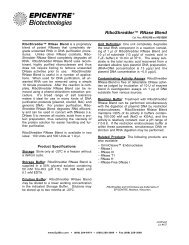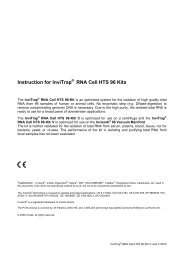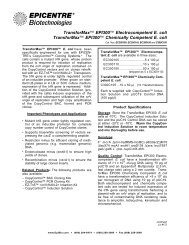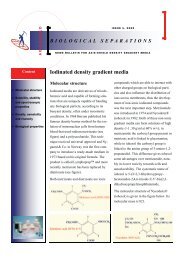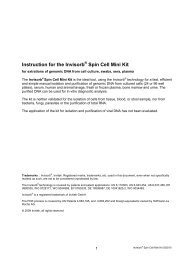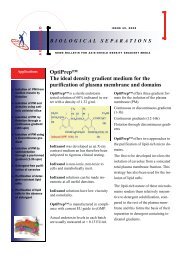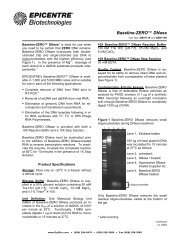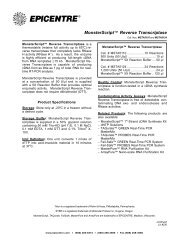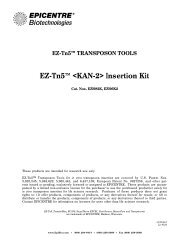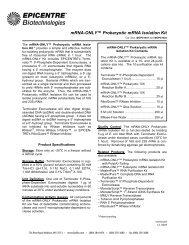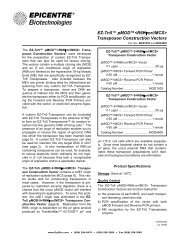Protocol for MasterAmp™ Extra-Long PCR Kit, MasterAmp™ Extra ...
Protocol for MasterAmp™ Extra-Long PCR Kit, MasterAmp™ Extra ...
Protocol for MasterAmp™ Extra-Long PCR Kit, MasterAmp™ Extra ...
- No tags were found...
Create successful ePaper yourself
Turn your PDF publications into a flip-book with our unique Google optimized e-Paper software.
EPICENTREMasterAmp <strong>Extra</strong>-<strong>Long</strong> <strong>PCR</strong> <strong>Kit</strong>MasterAmp <strong>Extra</strong>-<strong>Long</strong> <strong>PCR</strong> 2X PreMixesMasterAmp <strong>Extra</strong>-<strong>Long</strong> DNA Polymerase MixGeneral Considerations1. Template: The purity and integrity of the template DNA is very critical to the success of long <strong>PCR</strong>amplification. DNA prepared using standard isolation techniques is generally suitable <strong>for</strong> amplification.Nevertheless, numerous compounds inhibit amplification including ionic detergents, somegel loading dyes, phenol, and hemin. When purifying templates from agarose gels, minimize exposureto UV irradiation to prevent <strong>for</strong>mation of pyrimidine dimers. Assemble reactions in a cleanarea or use positive displacement pipettors with aerosol-barrier tips to minimize contamination riskfrom extraneous DNA templates. The optimal template amount <strong>for</strong> long <strong>PCR</strong> amplification may be4-5 times greater than standard <strong>PCR</strong>. For example, 1 ng of lambda DNA, 100 ng of E. coli DNAor 100-500 ng of human DNA is typically used <strong>for</strong> long <strong>PCR</strong>, though this may vary depending onthe source and quality of the template, as well as the length of the <strong>PCR</strong> product. 92. Primer Design: We recommend designing primers 20-30 bases in length containing 40-60%G+C residues with melting temperatures of 62-70 o C. Optimal primer pair annealing temperaturesshould be within 2-5 degrees of each other. Take care to design primers that do not <strong>for</strong>m hairpinloop structures or are self-complementary. The 5’ primer end may contain bases not complementaryto the template; however, the 3’ primer end must be complementary to the template. Primersof 30-35 bases in length are also commonly used <strong>for</strong> long <strong>PCR</strong> to achieve high specificity.3. Reaction Components: Mg 2+ concentration is particularly critical <strong>for</strong> amplification of a specifictarget. Excess Mg 2+ results in accumulation of nonspecific amplification products, while insufficientMg 2+ results in reduced yield of the desired of <strong>PCR</strong> product. The primer-to-template ratio isimportant <strong>for</strong> controlling the amplification specificity and efficiency; primer excess ensures the denaturedtemplate molecules bind to the primers instead the complementary DNA strand. 10Nevertheless,too much primer may lead to nonspecific product <strong>for</strong>mation or primer dimers. 200 mM(final concentration) of each dNTP (already included in the 2X <strong>Long</strong> <strong>PCR</strong> PreMixes), is sufficient<strong>for</strong> most <strong>PCR</strong> amplification. However, if desirable, additional dNTPs may be added to the reaction(dNTP stock solutions are available separately).4. Cycling Parameters: Many parameters influence both the specificity and efficiency of amplificationincluding the temperature and duration of denaturation, annealing, and extension, as well asramp speed and cycle number. Moderate denaturation temperatures and short incubation periodswill help maintain the integrity of long DNA templates. Programming an increase in extensiontime automatically <strong>for</strong> later cycles may also improve the yields of long amplification. 20-30 cyclesof amplification is typically sufficient, since amplification beyond ~10 12molecules may result innonspecific products. 8Additional variations such as use of a “hot start” 11 or touchdown/stepdown<strong>PCR</strong> 12,13 may also dramatically improve specificity and yield.5. DNA Polymerase: Amplification of sequences longer than 5 kb may be difficult with Taq DNApolymerase alone. There<strong>for</strong>e, inclusion of a small amount of 3’Æ5’ proofreading DNA polymeraseis commonly recommended <strong>for</strong> amplifications longer than 5 kb. Addition of larger DNA polymeraseamounts than <strong>for</strong> standard <strong>PCR</strong> may also be necessary to achieve longer amplification.6. Cosolvents: Cosolvents are typically used to improve <strong>PCR</strong> amplification. Glycerol, gelatin 14 ,DMSO 15 , and betaine 16 can improve long <strong>PCR</strong> amplification. Varying concentrations of Master-Amp 10X <strong>PCR</strong> Enhancer (with betaine) are already included in the MasterAmp <strong>Extra</strong>-<strong>Long</strong> <strong>PCR</strong>2X PreMixes <strong>for</strong> fast and convenient long <strong>PCR</strong> optimization.page 2




